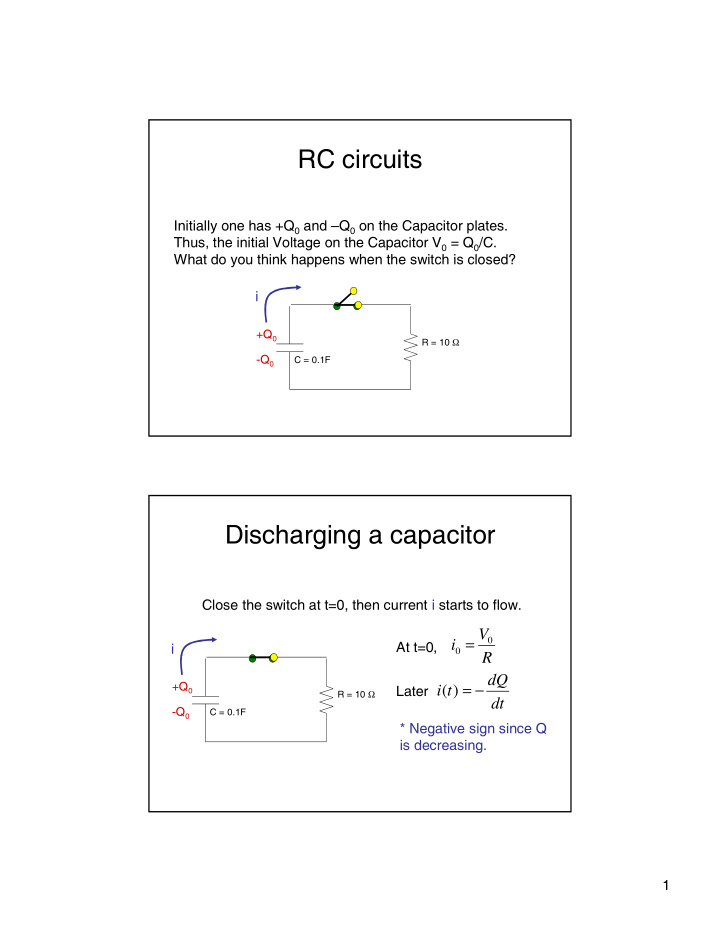



RC circuits Initially one has +Q 0 and –Q 0 on the Capacitor plates. Thus, the initial Voltage on the Capacitor V 0 = Q 0 /C. What do you think happens when the switch is closed? i +Q 0 R = 10 Ω -Q 0 C = 0.1F Discharging a capacitor Close the switch at t=0, then current i starts to flow. V 0 = i 0 At t=0, i R dQ = − +Q 0 i ( t ) Later R = 10 Ω dt -Q 0 C = 0.1F * Negative sign since Q is decreasing. 1
Discharging a capactiror Voltage across C = Voltage across R i V = V c R +Q 0 Q dQ = = − iR R -Q 0 C = 0.1F C dt dQ 1 = − Q dt RC We now need to solve this differential equation. Discharging a capacitor Solving the differential equation: dQ 1 = − − = t / RC Q Q ( t ) Q e 0 dt RC Check solution by taking the derivative... dQ 1 1 ⎛ − ⎞ − = t / RC = − Q e Q ⎜ ⎟ 0 dt RC RC ⎝ ⎠ RC = = = − 0 / Q ( t 0 ) Q e Q Also Q(t) = Q 0 at t=0. 0 0 2
Discharging a capacitor = − t / RC Q ( t ) Q e Exponential Decay 0 Q(t) After a time τ = RC, Q has dropped by e -1 = 1/e. Q 0 After a time t = 2RC, Q has dropped by e -2 = 1/e 2 Thus τ =RC is often called the time Q 0 /e constant and has units [seconds]. τ time Discharging a capacitor dQ ⎛ − 1 ⎞ 1 − = t / RC = − Q e Q ⎜ ⎟ 0 dt RC RC ⎝ ⎠ dQ ⎛ Q ⎞ − − = = t / RC = t / RC | i ( t ) | | | 0 e i e ⎜ ⎟ 0 dt RC ⎝ ⎠ Thus, the current also falls with the same exponential function. 3
Clicker Question A capacitor with capacitance 0.1F in an RC circuit is initially charged up to an initial voltage of V o = 10V and is then discharged through an R=10 Ω resistor as shown. The switch is closed at time t=0. Immediately after the switch is closed, the initial current is I o =V o /R=10V/10 Ω . What is the current I through the resistor at time t=2.0 s? A)1A B) 0.5A D) 1/e 2 A = 0.14A C) 1/e A = 0.37A R=10 Ω C=0.1F E) None of these. Answer: 1/e2 A = 0.14A. The time constant for this circuit is RC=(10 Ω )(0.10F) = 1.0 sec. So at time t=2.0 sec, two time constants have passed. After one time constant, the voltage, charge, and current have all decreased by a factor of e. After two time constants, everything has fallen by e2. The initial current is 1A. So after two time constants, the current is 1/e2 A = 0.135A. Charging a capacitor More complex RC circuit: Charging C with a battery. Ω R = 10 Before switch closed i=0, and V=10V charge on capacitor Q=0. C=0.0010 F Close switch at t=0. + + + = V V V 0 Try Voltage loop rule. b R C + − − = V b iR Q / C 0 4
Charging a capacitor + − − = V b iR Q / C 0 dQ + − − = V b R Q / C 0 dt ( ) dQ V Q b − = + = − − t / RC Q ( t ) CV 1 e b dt R RC Charging a capacitor ( ) = − − t / RC Q ( t ) CV 1 e Q b dQ V b e = = − t / RC i ( t ) ( t ) dt R time dQ R = 10 Ω i = dt V=10V C=0.0010 F time •Although no charge actually passes between the capacitor plates, it acts just like a current is flowing through it. •Uncharged capacitors act like a “short”: V C =Q/C=0 •Fully charged capacitors act like an “open circuit”. Must have i C = 0 eventually, otherwise Q � infinity. 5
Clicker Question An RC circuit is shown below. Initially the switch is open and the capacitor has no charge. At time t=0, the switch is closed. What is the voltage across the capacitor immediately after the switch is closed (time = 0)? R = 10 Ω A) Zero B) 10 V V=10V C) 5V D) None of these. C=0.0010 F 6
Recommend
More recommend